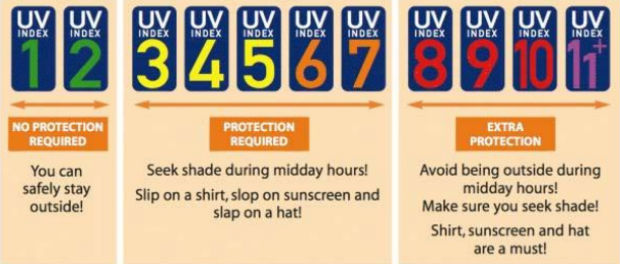New UV Index Reading Helps Protect From Sun
In order to help protect those on the island from the harmful ultraviolet [UV] radiation produced by the sun, Bermuda Cancer and Health Centre is teaming up with the Bermuda Weather Service and its newly launched UV Index reading in order to promote awareness of the dangers posed by the sun, as well as how to avoid and combat them.
The UV Index [UVI] reading, launched on July 16, 2014, is a valuable tool in providing the general public with knowledge that will enable them to adequately protect themselves from the damaging effects of UV radiation.
When asked how the UVI will benefit Bermudians, the Bermuda Cancer and Health Centre said, “The level of radiation from the sun changes on a daily basis and is reported on a scale from 0 to 11+, with 11+ being high and extreme. This is of great benefit and importance to parents, caregivers, those who work outdoors, or anyone who engages in extended outdoor activities.
“It’s imperative that the public utilise the daily UVI reading and take the suggestions for protecting oneself on any given day.
“UV radiation is so dangerous that in July 2014, the Surgeon General gave a call for action to the nation to combat skin cancer. Radiation from the sun burns our skin when not properly protected; no matter what color our skin, tanned skin is, in fact, damaged skin.”
Regarding the inherent risk of skin cancer that UV radiation presents, the Bermuda Cancer and Health Centre said, “There are three main types of skin cancer, with melanoma being the deadliest. UV radiation is the primary cause of melanoma. According to skincancer.org, melanoma is the most common cancer diagnosed in people aged 25-29 and the second most common in people aged 15-29.
“The rates for this diagnosis have tripled over the last 30 years and skin cancer is more common than all the other cancers combined.
“One or more blistering sunburns in childhood or adolescence more than doubles a person’s chances of developing melanoma later in life, so it’s important to get children exercising “sun smart” behaviours at a young age.”
The UV Index [UVI]
In response to these risks, the Bermuda Cancer and Health Centre has launched its SunSmart programme, aiming to educate the public not only about the dangers inherent in sun exposure, but also about how to protect themselves.
“Bermuda Cancer and Health Centre’s SunSmart Programme works closely with summer camps and gives presentations in the school system, preschool through high school, educating campers, students, and caregivers on the importance of protecting themselves from the sun.
“The sun is a good resource of energy, and vitamin D and can benefit us, but it can also harm us when not exercising SunSmart behaviours.
“According to the Bermuda National Tumor Registry, Bermuda’s incident rate of melanoma in the adult population is 12 percent higher than reported by the National Cancer Institute for the United States. It is important to note that the reporting of cancer diagnoses is not mandatory in Bermuda at this time.
“This leads one to believe that the incidents of skin cancer may actually be higher, as not all local physicians submit reports and those diagnosed overseas are not likely to have been included in the reporting either.”
The official SunSmart Protection Guidelines advise that the following steps be practiced when one is planning to be out in the sun for extended periods:
- Slip on a long sleeved shirt or any protective clothing
- Slop on sunscreen 20 to 30 minutes before going outside. Use broad spectrum with SPF 30+ and reapply every two hours
- Slap on a broad brimmed hat
- Seek shade between the hours of 10.00am and 4.00pm
- Slide on close fitted, wraparound sunglasses with UV protection
- Don’t forget to stay hydrated and drink lots of water
Schools, after school programmes, PTAs, and camps are invited to contact Azuree Williams, SunSmart Coordinator at Bermuda Cancer and Health Centre, at sunsmart@chc.bm or 236-1001 ext.1005 in order to book a free SunSmart presentation.
Read More About
Category: All, Environment



Something new useful and innovative, how refreshing is that?….but….did that young lady ever find Sams son?
Bermudians do not need any metrics to tell us when its too darn hot.
I’m sure you’re not making the mistake of confusing ‘ hot ‘ with the UV index ?
When I was a kid and there wasn’t any knowledge of this stuff and the ozone layer hadn’t yet been decimated by CFCs the older folks would always say that even on a cloudy day in Bermuda you could still get a serious sunburn .
Well , last Tuesday when it was heavy overcast all day and we got about 2.75” of rain the UV index was 11 .
Good intention but let’s face it any offering by seco or BAS isn’t usually taken very seriously in the community, when is the last time we planned an event around their weather forecast…….
A step in the right direction, but almost useless information. Instead of saying, for instance, that the UV index will be 10 today, the index should be tabulated so that Bermudians know at what hours they will need to be extra careful: the UV index will NOT be 10 at 7:00 AM, but it may well be during the hours of say 1:00 – 4:00 PM. The UV index is important to know, but PLEASE present the information in a meaningful format!!!